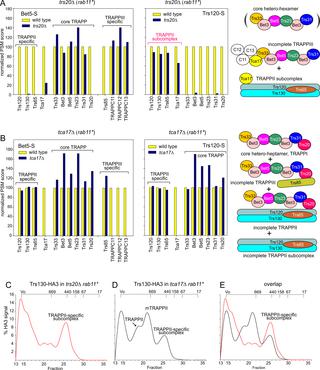当前位置:
X-MOL 学术
›
PLOS Genet.
›
论文详情
Our official English website, www.x-mol.net, welcomes your
feedback! (Note: you will need to create a separate account there.)
Characterization of Aspergillus nidulans TRAPPs uncovers unprecedented similarities between fungi and metazoans and reveals the modular assembly of TRAPPII.
PLOS Genetics ( IF 4.0 ) Pub Date : 2019-12-23 , DOI: 10.1371/journal.pgen.1008557 Mario Pinar 1 , Ernesto Arias-Palomo 2 , Vivian de Los Ríos 3 , Herbert N Arst 4 , Miguel A Peñalva 1
PLOS Genetics ( IF 4.0 ) Pub Date : 2019-12-23 , DOI: 10.1371/journal.pgen.1008557 Mario Pinar 1 , Ernesto Arias-Palomo 2 , Vivian de Los Ríos 3 , Herbert N Arst 4 , Miguel A Peñalva 1
Affiliation

|
TRAnsport Protein Particle complexes (TRAPPs) are ubiquitous regulators of membrane traffic mediating nucleotide exchange on the Golgi regulatory GTPases RAB1 and RAB11. In S. cerevisiae and metazoans TRAPPs consist of two large oligomeric complexes: RAB11-activating TRAPPII and RAB1-activating TRAPPIII. These share a common core TRAPPI hetero-heptamer, absent in metazoans but detected in minor proportions in yeast, likely originating from in vitro-destabilized TRAPPII/III. Despite overall TRAPP conservation, the budding yeast genome has undergone extensive loss of genes, and lacks homologues of some metazoan TRAPP subunits. With nearly twice the total number of genes of S. cerevisiae, another ascomycete Aspergillus nidulans has also been used for studies on TRAPPs. We combined size-fractionation chromatography with single-step purification coupled to mass-spectrometry and negative-stain electron microscopy to establish the relative abundance, composition and architecture of Aspergillus TRAPPs, which consist of TRAPPII and TRAPPIII in a 2:1 proportion, plus a minor amount of TRAPPI. We show that Aspergillus TRAPPIII contains homologues of metazoan TRAPPC11, TRAPPC12 and TRAPPC13 subunits, absent in S. cerevisiae, and establish that these subunits are recruited to the complex by Tca17/TRAPPC2L, which itself binds to the 'Trs33 side' of the complex. Thus Aspergillus TRAPPs compositionally resemble mammalian TRAPPs to a greater extent than those in budding yeast. Exploiting the ability of constitutively-active (GEF-independent, due to accelerated GDP release) RAB1* and RAB11* alleles to rescue viability of null mutants lacking essential TRAPP subunits, we establish that the only essential role of TRAPPs is activating RAB1 and RAB11, and genetically classify each essential subunit according to their role(s) in TRAPPII (TRAPPII-specific subunits) or TRAPPII and TRAPPIII (core TRAPP subunits). Constitutively-active RAB mutant combinations allowed examination of TRAPP composition in mutants lacking essential subunits, which led to the discovery of a stable Trs120/Trs130/Trs65/Tca17 TRAPPII-specific subcomplex whose Trs20- and Trs33-dependent assembly onto core TRAPP generates TRAPPII.
中文翻译:

构巢曲霉TRAPPs的表征揭示了真菌和后生动物之间前所未有的相似性,并揭示了TRAPPII的模块化组装。
TRAnsport蛋白颗粒复合物(TRAPPs)是介导高尔基调节性GTPases RAB1和RAB11上核苷酸交换的膜运输的无处不在的调节剂。在酿酒酵母和后生动物中,TRAPPs由两个大的寡聚复合物组成:激活RAB11的TRAPPII和激活RAB1的TRAPPIII。它们共有一个共同的核心TRAPPI异七聚体,在后生动物中不存在,但在酵母中检出的比例很小,可能源自体外不稳定的TRAPPII / III。尽管总体上TRAPP保守,发芽的酵母基因组已遭受广泛的基因损失,并缺乏某些后生的TRAPP亚基的同源物。酿酒酵母的基因总数几乎是啤酒酵母的两倍,它也被用于研究曲霉的构巢曲霉。我们将大小分级色谱与一步纯化相结合,再结合质谱和负污染电子显微镜,以建立曲霉形TRAPPs的相对丰度,组成和结构,该曲霉由TRAPPII和TRAPPIII以2:1的比例组成,再加上少量的TRAPPI。我们显示曲霉TRAPPIII包含酿酒酵母中不存在的后生动物TRAPPC11,TRAPPC12和TRAPPC13亚基的同源物,并确定这些亚基被Tca17 / TRAPPC2L募集到复合物中,而Tca17 / TRAPPC2L本身与复合物的``Trs33侧''结合。因此,曲霉菌TRAPPs在组成上与哺乳动物TRAPPs的相似程度要比发芽酵母中的大。利用本构主动(独立于GEF,(由于GDP释放加快)RAB1 *和RAB11 *等位基因可挽救缺少必需TRAPP亚基的无效突变体的生存力,我们确定TRAPPs的唯一基本作用是激活RAB1和RAB11,并根据其作用进行基因分类。 )或TRAPPII和TRAPPIII(核心TRAPP亚基)中的)。组成型活性RAB突变体组合可检测缺乏必需亚基的突变体中的TRAPP组成,从而发现了稳定的Trs120 / Trs130 / Trs65 / Tca17 TRAPPII特异性亚复合物,其依赖于Trs20和Trs33的组装至核心TRAPP的分子产生了TRAPPII。并根据其在TRAPPII(TRAPPII特异性亚基)或TRAPPII和TRAPPIII(核心TRAPP亚基)中的作用进行遗传分类。组成型活性RAB突变体组合可检测缺乏必需亚基的突变体中的TRAPP组成,从而发现了稳定的Trs120 / Trs130 / Trs65 / Tca17 TRAPPII特异性亚复合物,其依赖于Trs20和Trs33的组装至核心TRAPP的分子产生了TRAPPII。并根据其在TRAPPII(TRAPPII特异性亚基)或TRAPPII和TRAPPIII(核心TRAPP亚基)中的作用进行遗传分类。组成型活性RAB突变体组合可检测缺乏必需亚基的突变体中的TRAPP组成,从而发现了稳定的Trs120 / Trs130 / Trs65 / Tca17 TRAPPII特异性亚复合物,其依赖于Trs20和Trs33的组装至核心TRAPP的分子产生了TRAPPII。
更新日期:2019-12-25
中文翻译:

构巢曲霉TRAPPs的表征揭示了真菌和后生动物之间前所未有的相似性,并揭示了TRAPPII的模块化组装。
TRAnsport蛋白颗粒复合物(TRAPPs)是介导高尔基调节性GTPases RAB1和RAB11上核苷酸交换的膜运输的无处不在的调节剂。在酿酒酵母和后生动物中,TRAPPs由两个大的寡聚复合物组成:激活RAB11的TRAPPII和激活RAB1的TRAPPIII。它们共有一个共同的核心TRAPPI异七聚体,在后生动物中不存在,但在酵母中检出的比例很小,可能源自体外不稳定的TRAPPII / III。尽管总体上TRAPP保守,发芽的酵母基因组已遭受广泛的基因损失,并缺乏某些后生的TRAPP亚基的同源物。酿酒酵母的基因总数几乎是啤酒酵母的两倍,它也被用于研究曲霉的构巢曲霉。我们将大小分级色谱与一步纯化相结合,再结合质谱和负污染电子显微镜,以建立曲霉形TRAPPs的相对丰度,组成和结构,该曲霉由TRAPPII和TRAPPIII以2:1的比例组成,再加上少量的TRAPPI。我们显示曲霉TRAPPIII包含酿酒酵母中不存在的后生动物TRAPPC11,TRAPPC12和TRAPPC13亚基的同源物,并确定这些亚基被Tca17 / TRAPPC2L募集到复合物中,而Tca17 / TRAPPC2L本身与复合物的``Trs33侧''结合。因此,曲霉菌TRAPPs在组成上与哺乳动物TRAPPs的相似程度要比发芽酵母中的大。利用本构主动(独立于GEF,(由于GDP释放加快)RAB1 *和RAB11 *等位基因可挽救缺少必需TRAPP亚基的无效突变体的生存力,我们确定TRAPPs的唯一基本作用是激活RAB1和RAB11,并根据其作用进行基因分类。 )或TRAPPII和TRAPPIII(核心TRAPP亚基)中的)。组成型活性RAB突变体组合可检测缺乏必需亚基的突变体中的TRAPP组成,从而发现了稳定的Trs120 / Trs130 / Trs65 / Tca17 TRAPPII特异性亚复合物,其依赖于Trs20和Trs33的组装至核心TRAPP的分子产生了TRAPPII。并根据其在TRAPPII(TRAPPII特异性亚基)或TRAPPII和TRAPPIII(核心TRAPP亚基)中的作用进行遗传分类。组成型活性RAB突变体组合可检测缺乏必需亚基的突变体中的TRAPP组成,从而发现了稳定的Trs120 / Trs130 / Trs65 / Tca17 TRAPPII特异性亚复合物,其依赖于Trs20和Trs33的组装至核心TRAPP的分子产生了TRAPPII。并根据其在TRAPPII(TRAPPII特异性亚基)或TRAPPII和TRAPPIII(核心TRAPP亚基)中的作用进行遗传分类。组成型活性RAB突变体组合可检测缺乏必需亚基的突变体中的TRAPP组成,从而发现了稳定的Trs120 / Trs130 / Trs65 / Tca17 TRAPPII特异性亚复合物,其依赖于Trs20和Trs33的组装至核心TRAPP的分子产生了TRAPPII。











































 京公网安备 11010802027423号
京公网安备 11010802027423号